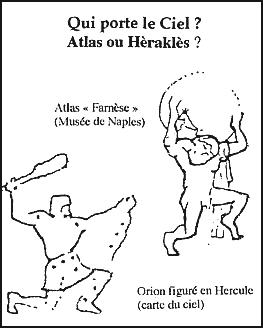
Measuring time in "moons"
TABLE OF CONTENTS
Home page
The awaited return of the most obvious seasonal signal
The "brilliant" sectors of the sky
An assembly of sacred images
Figures portrayed
by stars in the night,
by nature "dramatic" figures
Why make reference to
seasonal stars.
Measuring time in "moons"
When lunar imagery is combined
with stellar imagery to compose
a "mythical cinema"
The human condition
and its development
in the
collective memory
More
French version
Herakles, Hercules, Hercle: a "Herculean" calendar
Once again, mythical memory is precise: an episode from the legend of Herakles recalls that the muscular hero played the role of Atlas in his Garden, that he held up the sky and handled the Golden Apples. In distant times, the Herculean image was also the "media" on which a religious calendar was fixed.

From that point on, we can understand that sky maps portray Orion as Hercules. We can also understand that the Greek tradition, revived by Pindar, attributed the organization of the calendar to Olympic Games at Herakles. However, we know that the Olympiad defined a cycle of 50 moons, which is about 4 solar years. This cycle of 4 complete years also called the "Pythiad", also governed the Delphic Games, and Herakles could not help but be present in Delphic legends, as we will see below
The myth of the "Birth of Hercules", narrated in detail by Ovid, is remarkably clear on the point of insertion of a Thirteenth Moon: it shows us a circumstance where "time stands still" (another specific tradition is that at the birth of Hercules "the Sun stood still"). During this period of "time standing still" two "twins" appear one after the other: Hera-Kles and Iphi-Kles, two identical months of propitiatory sacrifices (the young girl Galanthis).
The names of Hera-Kles and Iphi-Kles clearly express the solemn character of the circumstances: Hera means "celestial" (Swar, Svar, Har, Her) and Iphi, "valiant soul". At the moment of the sacrifice, which corresponds to the position of the hero’s bludgeon (clava in Latin), they sing out:
KLw
Kal,Klaw,
the blow delivered from above
The "starting point", the "announcement" (kaleo: I call), the solemn proclamation (kleos: the sound that radiates) of the meeting that celebrates the entry into a new division of Time (India: Kala).
It is precisely this utterance that comes through the Roman Kalends (Kal-Andai) to ends up being our…
"calendar"
The name and the myth of Herakles-Hercules provides a remarkably coherent reminder that grand cyclic gatherings for religious celebrations existed in a much more distant past than commonly thought.

While the images Atl-Ant, Atal-Ante appear to correspond to a culture of nomadic and semi-nomadic hunters-gatherers, Herakles’ legend seems to reflect the preoccupations of livestock herders primarily concerned with bovines and equines, and with defending their territory against plundering "savages". Millennia pass: the three stars of Orion’s belt are no longer considered as Three Fruits, but as a bronze Tripod… Yes, we are in the Age of metal. In a celebrated episode of the great Herakles’ myth, often figuring on the metopes of temples, he tries to hold on to the new symbol of the opening of the festivities, the shining tripod, but has to abandon it to the hands of Apollo and to bow down at Delphi to new structures of the religious times.